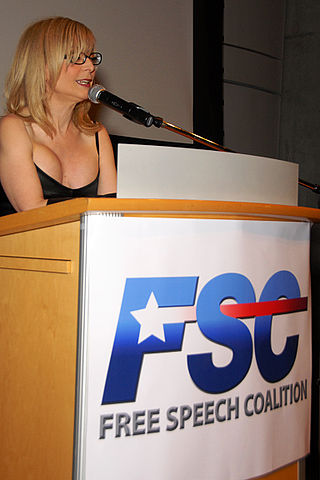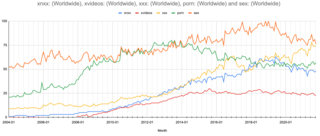Related Research Articles

Pornography has existed since the origins of the United States, and has become more readily accessible in the 21st century. Advanced by technological development, it has gone from a hard-to-find "back alley" item, beginning in 1969 with Blue Movie by Andy Warhol, the Golden Age of Porn (1969–1984) and home video, to being more available in the country and later, starting in the 1990s, readily accessible to nearly anyone with a computer or other device connected to the Internet. The U.S. has no current plans to block explicit content from children and adolescents, as many other countries have planned or proceeded to do.

R18 is a film or video classification given by the British Board of Film Classification (BBFC). It is intended to provide a classification for works that do not breach UK law, but exceed what the BBFC considers acceptable in the 18 category. In practice, this means hardcore pornography.

Pornography laws by region vary throughout the world. The production and distribution of pornographic films are both activities that are lawful in many, but by no means in all countries so long as the pornography features performers aged above a certain age, usually 18 years. Further restrictions are often placed on such material.
Rape pornography is a subgenre of pornography involving the description or depiction of rape. Such pornography either involves simulated rape, wherein sexually consenting adults feign rape, or it involves actual rape. Victims of actual rape may be coerced to feign consent such that the pornography produced deceptively appears as simulated rape or non-rape pornography. The depiction of rape in non-pornographic media is not considered rape pornography. Simulated scenes of rape and other forms of sexual violence have appeared in mainstream cinema, including rape and revenge films, almost since its advent.

The PROTECT Act of 2003 is a United States law with the stated intent of preventing child abuse as well as investigating and prosecuting violent crimes against children. "PROTECT" is a backronym which stands for "Prosecutorial Remedies and Other Tools to end the Exploitation of Children Today".

Pornography has been dominated by a few pan-European producers and distributors, the most notable of which is the Private Media Group that successfully claimed the position previously held by Color Climax Corporation in the early 1990s. Most European countries also have local pornography producers, from Portugal to Serbia, who face varying levels of competition with international producers. The legal status of pornography varies widely in Europe; its production and distribution are illegal in countries such as Ukraine, Belarus and Bulgaria, while Hungary has liberal pornography laws.

The Free Speech Coalition (FSC) is a non-profit trade association of the pornography and adult entertainment industry in the United States. Founded in 1991, it opposes the passage and enforcement of obscenity laws and many censorship laws.
Pornography has been defined as sexual subject material "such as a picture, video, or text" that is intended for sexual arousal. Indicated for the consumption by adults, pornography depictions have evolved from cave paintings, some forty millennia ago, to virtual reality presentations. A general distinction of adult content is made classifying it as pornography or erotica.
Internet censorship in the United Kingdom is conducted under a variety of laws, judicial processes, administrative regulations and voluntary arrangements. It is achieved by blocking access to sites as well as the use of laws that criminalise publication or possession of certain types of material. These include English defamation law, the Copyright law of the United Kingdom, regulations against incitement to terrorism and child pornography.
Section 63 of the Criminal Justice and Immigration Act 2008 is a law in the United Kingdom criminalising possession of what it refers to as "extreme pornographic images". The law came into force on 26 January 2009. The legislation was brought in following the murder of Jane Longhurst by a man who was said at the time of his trial to have had "extreme pornography" in his possession at the time of the death. The law has been more widely used than originally predicted, raising concerns as to whether the legislation is being used for prosecutions beyond the scope originally envisaged by parliament.
Legal frameworks around fictional pornography depicting minors vary depending on country and nature of the material involved. Laws against production, distribution and consumption of child pornography generally separate images into three categories: real, pseudo, and virtual. Pseudo-photographic child pornography is produced by digitally manipulating non-sexual images of real minors to make pornographic material. Virtual child pornography depicts purely fictional characters. "Fictional pornography depicting minors", as covered in this article, includes these latter two categories, whose legalities vary by jurisdiction, and often differ with each other and with the legality of real child pornography.

Internet pornography is any pornography that is accessible over the internet; primarily via websites, FTP connections, peer-to-peer file sharing, or Usenet newsgroups. The greater accessibility of the World Wide Web from the late 1990s led to an incremental growth of internet pornography, the use of which among adolescents and adults has since become increasingly popular.
An obscenity is any utterance or act that strongly offends the prevalent morality and social politics of the time. It is derived from the Latin obscēnus, obscaenus, "boding ill; disgusting; indecent", of uncertain etymology. Such loaded language can be used to indicate strong moral repugnance and outrage, vile, vigilance in conservation, or revenge. In expressions such as "obscene profits" and "the obscenity of war," ; misdirection. As a legal term, it usually refers to graphic depictions of people engaged in sexual and excretory activity, and related utterances of profanity, or the exploited child, human being or situation on display. It may also relate to a fear quotient in the public area affecting trend.
In the United States, child pornography is illegal under federal law and in all states and is punishable by up to life imprisonment and fines of up to $250,000. U.S. laws regarding child pornography are virtually always enforced and amongst the harshest in the world. The Supreme Court of the United States has found child pornography to be outside the protections of the First Amendment to the United States Constitution. Federal sentencing guidelines on child pornography differentiate between production, distribution, and purchasing/receiving, and also include variations in severity based on the age of the child involved in the materials, with significant increases in penalties when the offense involves a prepubescent child or a child under the age of 18. U.S. law distinguishes between pornographic images of an actual minor, realistic images that are not of an actual minor, and non-realistic images such as drawings. The latter two categories are legally protected unless found to be obscene, whereas the first does not require a finding of obscenity.
Simulated child pornography is child pornography depicting what appear to be minors but which is produced without their direct involvement.
The production, sale, distribution, and commercialization of child pornography in Japan is illegal under the Act on Punishment of Activities Relating to Child Prostitution and Child Pornography, and the Protection of Children (1999), and is punishable by a maximum penalty of five years in prison and/or a fine of ¥5,000,000. Simple possession of child pornography was made illegal by an amendment to the act in 2014. Virtual child pornography, which depicts wholly-fictional characters, is legal to produce and possess.
Pornography in the Americas consists of pornography made and viewed in North, Central and South American and Caribbean countries and territories. The culture of Latin America and French America has traditionally been strongly influenced by the Roman Catholic Church, which tends to be socially conservative. Pornography is least restricted and essentially legal in those countries where the Catholic church is politically and socially the weakest, such as Brazil, Colombia and Mexico. The viewing of pornography in the region has been popularized by the Internet and DVDs.
Sable Communications of California v. Federal Communications Commission, 492 U.S. 115 (1989), was a United States Supreme Court case involving the definition of "indecent material" and whether it is protected under the First Amendment to the United States Constitution. The Court invalidated part of a federal law that prohibited "dial-a-porn" telephone messaging services by making it a crime to transmit commercial telephone messages that were either "obscene" or "indecent".
United States obscenity law deals with the regulation or suppression of what is considered obscenity and therefore not protected speech under the First Amendment to the United States Constitution. In the United States, discussion of obscenity typically relates to defining what pornography is obscene, as well as to issues of freedom of speech and of the press, otherwise protected by the First Amendment to the Constitution of the United States. Issues of obscenity arise at federal and state levels. State laws operate only within the jurisdiction of each state, and there are differences among such laws. Federal statutes ban obscenity and child pornography produced with real children. Federal law also bans broadcasting of "indecent" material during specified hours.

Connection Distributing Co. v. Holder, 557 F.3d 321 is a case in which the United States Court of Appeals for the Sixth Circuit held that the record-keeping provisions of the Child Protection and Obscenity Enforcement Act did not violate the First Amendment.
References
- Grudzen, Corita R.; Kerndt, Peter R. (June 19, 2007). "The Adult Film Industry: Time to Regulate?". PLOS Medicine. 4 (6): e126. doi: 10.1371/journal.pmed.0040126 . PMC 1892037 . PMID 17579507.
- Baram, M., ABC News: Free Porn Threatens Adult Film Industry, June 11, 2007, , accessed April 6, 2009.
- Paul Koretz (chair) (2004). Worker health and safety in the adult film industry (PDF) (Report). California State Assembly: Committee on Labor and Employment. Archived from the original (PDF) on 2008-08-07.
- Xtreme Magazine New England, http://xtrememagazine.com
- Baur, K & Crooks, R., Our Sexuality, 10th edition, Wadsworth Cengage Learning, 2008.